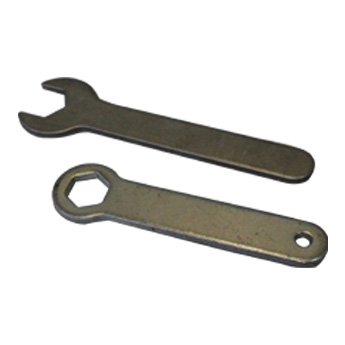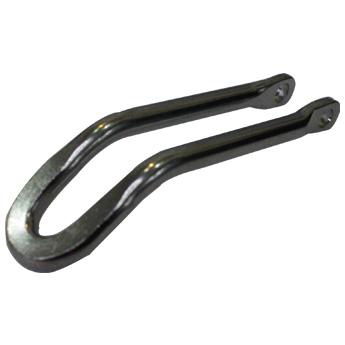沖壓模具
 沖壓模具開發設計是沖壓製造過程中至關重要的一個環節
沖壓模具開發設計是沖壓製造過程中至關重要的一個環節
冠豪工業社
電話:886-4-7696528 傳真:886-4-7685402
50441彰化縣秀水鄉曾厝村福陵巷75號
沖壓模具是沖壓工藝中的重要部分,是製作金屬製品的關鍵工具。它通常由上模、下模、模板和導向機構等部分組成,用於在金屬片材上施加壓力,使其按照所需形狀變形。
沖壓模具的種類非常多樣化,包括簡單模具、多工位模具、連續模具等。根據所需產品的形狀、大小和數量等不同條件,選擇不同類型的模具可以達到最佳的生產效果。
在沖壓模具的設計和製作過程中,需要考慮多種因素,如模具材料的選擇、模具結構的設計、模具加工和調試等。模具材料需要具有足夠的硬度和強度,以確保模具在使用過程中不會變形或損壞。模具結構的設計需要考慮產品的形狀、大小和製造工藝等因素,以確保模具能夠生產出符合要求的產品。模具加工和調試需要高度的技術和經驗,以確保模具的精度和穩定性。
冠豪工業社開發生產沖壓模具,擁有專業的技術團隊和現代化的生產設備,能夠設計和製造各種不同形狀和尺寸的沖壓模具,如汽車零配件模具、五金配件模具、家具五金配件模具、電子產品配件模具等。該公司的模具製作過程嚴格按照國際標準進行,確保產品的精度和質量。
該公司還通過不斷進行技術創新和產品研發,提高產品的品質和生產效率。該公司重視客戶的需求和滿意度,提供全方位的技術支持和服務,以滿足客戶的不同需求和要求。
 嚴格控制模具製造過程,確保每一個步驟都符合標準和技術要求,避免產生不必要的浪費和損失。沖壓模具開發設計是沖壓製造過程中最關鍵的步驟之一。良好的模具開發設計可以確保高品質、高效率的生產過程,並且可以最大程度地減少成本和減少生產周期。以下是沖壓模具開發設計的一些關鍵步驟:
嚴格控制模具製造過程,確保每一個步驟都符合標準和技術要求,避免產生不必要的浪費和損失。沖壓模具開發設計是沖壓製造過程中最關鍵的步驟之一。良好的模具開發設計可以確保高品質、高效率的生產過程,並且可以最大程度地減少成本和減少生產周期。以下是沖壓模具開發設計的一些關鍵步驟:
分析產品需求:了解客戶的產品需求和技術要求,確定產品的尺寸、形狀、數量等要素,以此為基礎開始設計模具。
設計模具結構:根據產品要求和加工工藝,設計適當的模具結構。模具結構包括上模、下模、模板、導向機構等部分,需要確保模具在使用過程中的精度和穩定性。
選擇模具材料:模具材料需要具有足夠的硬度和強度,能夠承受高強度的沖壓加工過程。常用的模具材料有SKD11、SKH-51、ASP23等。
設計模具的操作方式:操作方式包括手動、半自動和全自動三種方式,需要根據生產需求和預算等因素進行選擇和設計。
模具製造:根據設計圖紙和技術要求進行模具製造。製造過程包括加工、電鑄、熱處理等步驟,需要確保每一個步驟都符合標準和技術要求。
模具調試:模具製造完成後需要進行調試,確保模具能夠生產符合要求的產品。調試過程需要調整模具的壓力、速度、導向等參數,並且進行測試和檢查。
冠豪工業社生產沖壓模具,擁有專業的設計團隊和現代化的生產設備,能夠設計和製造各種不同形狀和尺寸的沖壓模具,如汽車零配件模具、五金配件模具、家具五金配件模具、電子產品配件模具等。該公司的模具製作過程嚴格按照國際標準進行,並且持續進行技術創新和產品研發,以提高產品的品質和生產效率。 擁有專業的設計團隊和現代化的生產設備,能夠設計和製造各種不同形狀和尺寸的沖壓模具
擁有專業的設計團隊和現代化的生產設備,能夠設計和製造各種不同形狀和尺寸的沖壓模具
在沖壓模具開發設計過程中,冠豪工業社遵循以下原則:
根據產品要求和加工工藝,設計適當的模具結構,確保模具能夠在使用過程中保持精度和穩定性。
嚴格控制模具製造過程,確保每一個步驟都符合標準和技術要求,避免產生不必要的浪費和損失。
提供全方位的技術支持和服務,與客戶密切合作,了解客戶的需求和要求,並且給予專業的建議和解決方案。
持續進行技術創新和產品研發,引進新技術和新材料,提高產品的質量和生產效率。
總之,沖壓模具開發設計是沖壓製造過程中至關重要的一個環節,需要在設計、製造和調試過程中嚴格控制每一個步驟,確保產品能夠符合客戶的要求和國際標準。冠豪工業社作為一家專業生產沖壓模具的公司,擁有豐富的經驗和專業技術,能夠為客戶提供最優質的產品和服務。
沖壓模具是製造業中的關鍵元素,它們在生產金屬零件、零件組件和產品方面扮演著重要角色。本文將深入探討沖壓模具的概念、種類、設計、製造過程、應用、挑戰和未來趨勢。通過這份2000字的文章,我們希望為讀者提供對沖壓模具技術的更深入了解,並認識到它對現代製造業的不可或缺性。
第一部分:沖壓模具的概念
沖壓模具,簡稱模具,是一種專用工具,用於將平板金屬材料或卷材通過壓力加工成所需的形狀和尺寸。模具通常由硬質合金、工具鋼或其他特殊材料製成,並由模具設計師根據具體的產品要求設計。沖壓模具的主要目標是實現高精度、高效率和一致性的金屬加工,這些都是現代製造業所需的關鍵要素。
第二部分:沖壓模具的種類
沖壓模具可以分為多種類型,其中一些包括:
單工序模具:用於簡單的沖壓操作,例如切割、成型和彎曲。這些模具通常用於製造小型零件。
多工序模具:包括多個連續的工序,每個工序使用不同的模具,最終將金屬材料轉化為複雜的零件或產品,例如汽車車身。
深拉伸模具:用於將金屬材料拉伸成深的形狀,如碗狀或罐狀,通常用於生產鍋具和容器。
壓鑄模具:用於壓鑄過程,將熔融金屬注入模具中,形成固體零件,通常用於高精度和複雜形狀的零件。
鳥嘴模具:用於製造帶有凸起或凹陷的金屬表面,如鍋爐管。
鍛造模具:用於鍛造過程,將金屬加熱至高溫,然後用模具加工成所需形狀,通常用於生產高強度的零件。
第三部分:沖壓模具的設計
沖壓模具的設計是一個關鍵的過程,它直接影響到最終產品的質量和形狀。以下是一些模具設計的關鍵考慮因素:
材料選擇:選擇適當的模具材料,通常是硬質合金或工具鋼,以確保模具具有足夠的硬度和耐用性。
形狀和尺寸:根據產品要求設計模具的形狀和尺寸,並確保模具能夠實現所需的加工操作。
冷卻系統:在模具中設計冷卻通道,以控制模具的溫度,防止過熱和模具磨損。
防粘涂層:在模具表面應用防粘涂層,以減少金屬粘附,提高模具的使用壽命。
放射孔:設計放射孔以便更容易從模具中取出加工完成的零件。
自動化特性:考慮模具的自動化特性,以實現高效率的生產。
模具生命週期:估算模具的預期生命週期,並規劃維護和修復。
第四部分:沖壓模具的製造過程
沖壓模具的製造過程包括以下幾個主要步驟:
設計和工程:根據產品要求,模具設計師創建詳細的設計圖紙,包括三維模型和製造指南。
材料準備:選擇合適的模具材料,將其切割成所需尺寸,並進行熱處理以提高硬度。
CNC加工:使用數控機床進行精確的加工,包括銑削、鏜孔和線切割等操作。
精密磨削:進行表面磨削和內孔磨削,以實現高度精確的模具。
裝配和調試:將各個模具部件組裝在一起,並進行調試和測試,以確保正確運作。
表面處理:根據需要,對模具進行表面處理,如鍍鉻、硝化或氮化,以提高其耐用性。
品質控制:對製造的模具進行嚴格的品質檢查,以確保符合設計要求。
使用和維護:模具在生產過程中需要進行定期的維護和保養,以延長其使用壽命。
第五部分:沖壓模具的應用
沖壓模具廣泛應用於各種行業,以下是一些主要的應用領域:
汽車工業:汽車車身、內飾零件、引擎部件等的生產都依賴於沖壓模具。
家電產業:許多家用電器,如洗衣機、冰箱、微波爐等,都包含著沖壓模具的零件。
電子產業:手機、平板電腦、筆記型電腦等的金屬外殼通常是通過沖壓模具製造的。
建築業:建築門窗、屋頂材料、建築組件等都需要沖壓模具來生產。
航空航天工業:飛機和航天器的各種零部件也是由沖壓模具生產的。
第六部分:沖壓模具的挑戰和未來趨勢
沖壓模具製造面臨著一些挑戰,同時也受到未來趨勢的影響:
挑戰:
成本高昂:製造高精度和複雜模具的成本相對較高,特別是對於小批量生產來說。
設計和製造時間:模具的設計和製造需要時間,這可能會延遲產品上市時間。
材料浪費:模具的製造過程中可能會產生材料浪費。
模具修復:隨著使用,模具會磨損和受損,需要定期維修和修復。
未來趨勢:
數字化製造:數字化技術將改變沖壓模具的設計和製造,使其更加智能化和自動化。
3D打印技術:3D打印技術將用於製造定制化和複雜的模具部件,以縮短生產周期。
材料創新:新材料的開發將改善模具的性能和壽命。
環保和可持續性:製造業將更加關注環保和可持續性,模具製造也不例外。
結論
沖壓模具是現代製造業的重要元素,它們在生產金屬零件和產品方面發揮著關鍵作用。這些模具的設計、製造和應用涉及多個關鍵考慮因素,需要高度的專業知識和技術。儘管面臨一些挑戰,但隨著技術的發展和創新,沖壓模具將繼續在製造業中扮演著不可或缺的角色。希望這份文章能夠幫助讀者更好地理解沖壓模具的重要性和多個方面的複雜性。
當談到沖壓模具時,還有許多有趣的方面和深入的內容可以探討。以下是一些更多有關沖壓模具的資訊和討論:
材料科學:深入探討用於製造模具的不同材料的特性,包括硬質合金、工具鋼、陶瓷等,以及它們在模具性能中的作用。
高精度加工:探討如何實現高精度加工,包括精密磨削、鏜孔、電火花加工等高精度加工技術的應用。
模具設計軟件:介紹現代模具設計軟件的使用,以提高模具設計的效率和精確性。
模具維護和修復:討論模具的定期維護和修復,以延長其使用壽命並減少生產中的停機時間。
高速沖壓:深入研究高速沖壓技術,包括高速沖床和高速加工方法,以提高生產效率。
模具生命週期管理:介紹模具生命週期管理的概念,包括模具的設計、製造、使用、維護和退役的全生命周期管理。
沖壓模具的可持續性:討論如何減少模具製造和使用過程中的環境影響,以實現更可持續的生產。
國際模具製造:探討不同國家和地區在模具製造方面的競爭優勢和技術發展。
模具行業的未來:預測未來模具行業的發展趨勢,包括技術創新、自動化和數字化製造的影響。
模具故事和成功案例:分享一些模具製造行業的成功案例和故事,以啟發讀者對這個領域的興趣。
這些更多的話題可以進一步深入探討沖壓模具的多個方面,並幫助讀者更全面地了解這一關鍵的製造技術。沖壓模具是現代製造業中不可或缺的一部分,它們影響著我們日常生活中許多產品的生產和質量,因此值得深入研究和探討。
